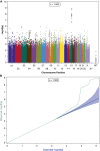Beyond cigarettes per day. A genome-wide association study of the biomarker carbon monoxide
- PMID: 25072098
- PMCID: PMC4214060
- DOI: 10.1513/AnnalsATS.201401-010OC
Beyond cigarettes per day. A genome-wide association study of the biomarker carbon monoxide
Abstract
Rationale: The CHRNA5-CHRNA3-CHRNB4 locus is associated with self-reported smoking behavior and also harbors the strongest genetic associations with chronic obstructive pulmonary disease (COPD) and lung cancer. Because the associations with lung disease remain after adjustment for self-reported smoking behaviors, it has been asserted that CHRNA5-CHRNA3-CHRNB4 variants increase COPD and lung cancer susceptibility independently of their effects on smoking.
Objectives: To compare the genetic associations of exhaled carbon monoxide (CO), a biomarker of current cigarette exposure, with self-reported smoking behaviors.
Methods: A total of 1,521 European American and 247 African American current smokers recruited into smoking cessation studies were assessed for CO at intake before smoking cessation. DNA samples were genotyped using the Illumina Omni2.5 microarray. Genetic associations with CO and smoking behaviors (cigarettes smoked per day, Fagerstrom test for nicotine dependence) were studied.
Measurements and main results: Variants in the CHRNA5-CHRNA3-CHRNB4 locus, including rs16969968, a nonsynonymous variant in CHRNA5, are genomewide association study-significantly associated with CO (β = 2.66; 95% confidence interval [CI], 1.74-3.58; P = 1.65 × 10(-8)), and this association remains strong after adjusting for smoking behavior (β = 2.18; 95% CI, 1.32-3.04; P = 7.47 × 10(-7)). The correlation between CO and cigarettes per day is statistically significantly lower (z = 3.43; P = 6.07 × 10(-4)) in African Americans (r = 0.14; 95% CI, 0.02-0.26; P = 0.003) than in European-Americans (r = 0.36; 95% CI, 0.31-0.40; P = 0.0001).
Conclusions: Exhaled CO, a biomarker that is simple to measure, captures aspects of cigarette smoke exposure in current smokers beyond the number of cigarettes smoked per day. Behavioral measures of smoking are therefore insufficient indices of cigarette smoke exposure, suggesting that genetic associations with COPD or lung cancer that persist after adjusting for self-reported smoking behavior may still reflect genetic effects on smoking exposure.
Keywords: chronic obstructive pulmonary disease; lung cancer; nicotine; nicotinic receptor; smoking.
Figures




Comment in
- doi: 10.1513/AnnalsATS.201407-315ED
References
-
- American Lung AssociationChronic Obstructive Pulmonary Disease (COPD) Fact Sheet. 2013[accessed 2013 Jun 7]. Available from: http://www.lung.org/lung-disease/copd/resources/facts-figures/COPD-Fact-...
Publication types
MeSH terms
Substances
Grants and funding
- U01HG004446/HG/NHGRI NIH HHS/United States
- P50DA019706/DA/NIDA NIH HHS/United States
- K08 DA030398/DA/NIDA NIH HHS/United States
- P01 CA089392/CA/NCI NIH HHS/United States
- P01 CA180945/CA/NCI NIH HHS/United States
- T32MH014677/MH/NIMH NIH HHS/United States
- K05CA139871/CA/NCI NIH HHS/United States
- K08DA030398/DA/NIDA NIH HHS/United States
- UL1 TR000448/TR/NCATS NIH HHS/United States
- 1 X01 HG005274-01/HG/NHGRI NIH HHS/United States
- P50CA084724/CA/NCI NIH HHS/United States
- P01CA089392/CA/NCI NIH HHS/United States
- K05 CA139871/CA/NCI NIH HHS/United States
- U01 HG004446/HG/NHGRI NIH HHS/United States
- R01 HL109031/HL/NHLBI NIH HHS/United States
- R01 DA026911/DA/NIDA NIH HHS/United States
- P50 DA019706/DA/NIDA NIH HHS/United States
- U01HG004422/HG/NHGRI NIH HHS/United States
- K08 DA032680/DA/NIDA NIH HHS/United States
- HHSN268200782096C/HG/NHGRI NIH HHS/United States
- P50 CA084724/CA/NCI NIH HHS/United States
- U01 HG004422/HG/NHGRI NIH HHS/United States
- R01DA026911/DA/NIDA NIH HHS/United States
- K02DA021237/DA/NIDA NIH HHS/United States
- K02 DA021237/DA/NIDA NIH HHS/United States
- T32 MH014677/MH/NIMH NIH HHS/United States
LinkOut - more resources
Full Text Sources
Other Literature Sources
Medical

